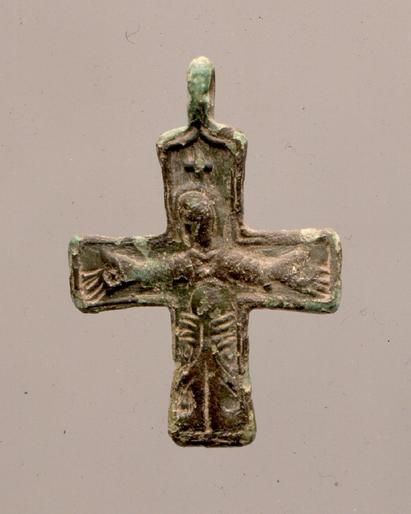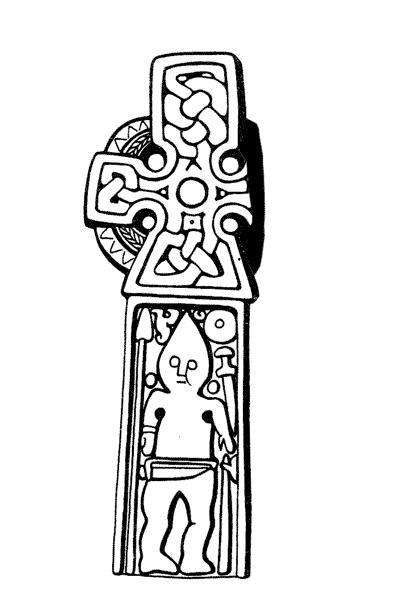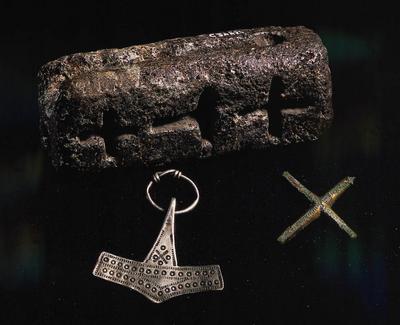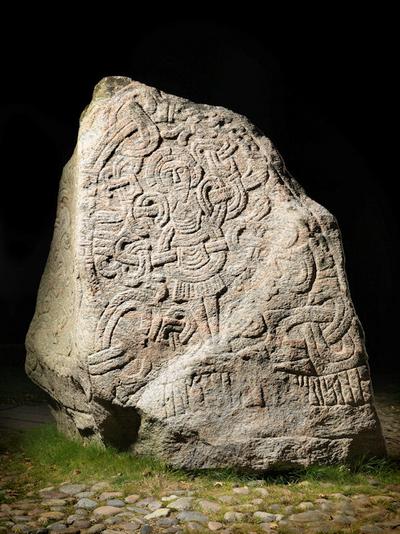Christianity comes to Denmark

In the Viking Age most of Europe had converted to Christianity, but the Vikings were very satisfied with their own gods and held on to them. Therefore the early missionaries, who came to Denmark in the 700s and 800s to spread the message of Christianity, had a hard job in convincing the Vikings that it was not the norns’ threads or Odin’s will that determined their path to the afterlife.
Christianity was regarded as a necessary evil by the Viking merchants in Europe, if they were to participate in trading contact with different believers. Therefore whilst abroad Viking traders often agreed to be marked with the sign of the cross – they renounced the old Nordic gods without necessarily receiving baptism.
The Vikings chose Christianity during the 900s, partly because of the extensive trade networks with Christian areas of Europe, but also particularly as a result of increasing political and religious pressure from the German empire to the south. By the end of the Viking period, around 1050, most Vikings were Christians. They were baptised, went to church and were buried in a Christian manner.
Harald Bluetooth's rune stone marks the transition

The transition to Christianity is marked by King Harald Bluetooth’s rune stone at Jelling, which dates to around 965. The stone displays an inscription which declares that Harald made the Danes Christian. But in reality the change in belief did not take place from one day to the next. Christian currents were apparent in Denmark long before King Harald’s time. South of the border Denmark’s neighbours were already Christian, around the beginning of the Viking period, in the late 700s.
The first Christian mission, that we have reports of, took place around 710, when the English archbishop Willibrord (c. 658-739) travelled to Denmark to undertake missionary activity. Here Willibrord came into contact with the king of the Danes, Ongendus (Agantyr). Willibrord seems to have been treated harshly, as he described the king as more cruel than any animal and harder than stone. This was probably the reason why Willibrord soon travelled home again. He came back with 30 boys, who were to be trained in the teachings of Christianity. Willibrord later undertook missionary work amongst the Frisians and became known as ‘the Apostle of the Frisians’.
By the 800s part of the population was already Christian. When King Harald announced the introduction of Christianity in the second half of the 900s, the old Nordic religion and Christianity had long existed side by side. Various objects from the Viking Age testify to this, such as the mould of soapstone found at Trend in Himmerland. The mould could be used for the production of crosses as well as Thor’s hammers. Thus the craftsman was able to provide pendants for customers adhering to both religions.
The Vikings learnt about Christianity on their journeys around the world or from monks who travelled to Scandinavia as missionaries. Whilst abroad, they became aware of the power of the Christian countries. They also saw impressive stone cathedrals and monasteries, with their associated riches, which they looted from time to time.
Baptism and marking with the sign of the cross
Many Viking traders were marked with the sign of the cross or baptised abroad. In order to be given the necessary privileges at trading centres in Christian towns, it was often a condition to be either Christian, or at least blessed.
Written sources mention a gift that came with baptism – a set of fine white clothes. This tempted many Vikings to be baptised. A monk called Notker attended a baptism ceremony at the Frankish court in the 800s, and described how a Viking was also present. Many people were baptised that day, and when it came to this individual’s turn, there were no more white clothes left. Therefore he was presented with a set of coarser and simpler clothes. When this happened he apparently said: Twenty times I have been bathed and given the best and whitest clothes, but such sackcloth is not fit for a warrior, it suits a swineherd better. And if it was not because I was ashamed of my nakedness, I would give you back both the clothes and your Christ …
It seems likely that Vikings did not become Christians overnight, just because they were baptised abroad. In Ansgar’s biography from the 800s we read that the baptism itself was something that the Vikings would rather wait with. They believed that it was best to be baptised, when they were old and were at the end of life.
Written sources indicate that baptism of the Vikings was the priority of the missionaries. Baptism was crucial for Christianity. According to the Church, once they had been baptised, people were precluded from participating in the pagan cult. As baptism was such a big step, the Church came up with “a smaller step”, which enabled Vikings to stand with a foot in both camps. In this non-Christians were marked with the sign of the cross in a non-committal precursor of baptism.
The Christianization process

The transition to Christianity in Denmark took place gradually and without major conflict. The Vikings regarded the new belief as supplementing the Nordic gods – it was not simply a choice between the old and the new religion. The Vikings’ belief in many gods meant that it was possible for the new Christian god, White Christ, to be worshipped alongside gods like Thor and Odin.
In this way both religious beliefs could exist alongside each other. One religion did not exclude the other. This is shown by the find of a mould, which the smith could use to make both Thor’s hammers and Christian crosses. It was a time of great change and perhaps the Vikings sought security in both religious creeds – just to be on the safe side.
Christianity slowly won a footing without the old belief being completely abandoned. Instead, it was reinterpreted and incorporated into the new Christian faith. The old belief also survived in popular folk beliefs. Here we find descriptions of big, stupid trolls and hear about gnomes, who are small bearded men. Is it the belief in giants and dwarves that has survived here?
Vikings could believe in several gods at the same time
In Norse mythology the world and nature were filled with forces equally real as human beings, and the relationship between humans and these forces was characterised by mutual dependence. In line with this way of thinking, it was likely that other cultures could have gods who were just as powerful as the Vikings' own gods.
It is of course hard to know what the individual Viking thought about the process of Christianization. The Vikings may have thought that they were hedging their bets by believing in the old gods as well as Christ. By believing in as many gods as possible, the likelihood was greater that one of these would be favourably disposed when required. For example, the Icelandic book Landnambók about Helge den Magre (Helge “the Lean”) describes how, although Helge believed in Christ, when at sea or in a particularly difficult situation he would pray to Thor.
A number of archaeological finds point towards a peaceful transition to the new belief. These include a smith’s mould from Trend in Jutland, which has spaces for two crosses and one hammer. The smith could use it to produce exactly which amulets his customers wanted. In addition, a medieval font from Gettrup, in Jutland, displays both crosses and Thor’s hammers. Several Thor’s hammers, which feature cross ornamentation, have also been found. The Viking belief in the Norse gods was thus reinterpreted and drawn into Christianity.
However, the Christianization process was not completely free of conflicts. They occurred, for example, when the missionaries demanded that the new faith should be the only way and the old gods completely abandoned. Conflicts occurred, for instance, when cult buildings and idols were destroyed. Even if the missionaries did their best to introduce Christianity, traces of the Norse gods were still evident up until the 1200s.



Religions at odds
The Vikings had to adopt a position regarding the old traditions that were on the way out and the new ones that were becoming more widespread. Accompanying Christianity were many new rules relating to baptism, church attendance, stricter conditions for marriage and burial in consecrated churchyards without grave goods. But most important of all was the belief in the one God.
After the introduction of Christianity, many practices were forbidden. Placing newborn children outside to die, for example, was no longer allowed. In addition, horsemeat was not to be eaten. The horse had great significance in the old religion because of Odin’s horse, Sleipnir.
But all opposition was not defeated overnight. Many Vikings continued to worship the Norse gods in secret or under the cloak of Christianity after the official Christianization of Denmark.
Buried so as to be on the safe side
A chambered tomb at Thumby-Bienebek in Schleswig-Holstein is evidence of a family covering different options. The buried woman wore a silver cross around her neck. She was therefore probably a Christian. However, several iron Thor’s hammers had also been nailed into the outside of the coffin. This was probably not according to the buried woman’s own wishes, but may instead show how her family wanted to be completely sure that all went as well as possible in the afterlife.
